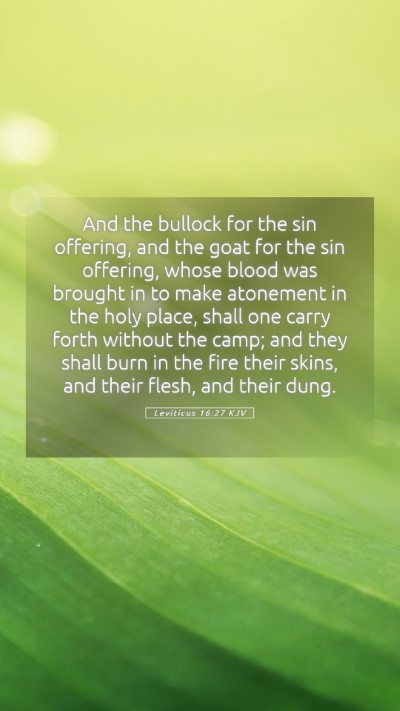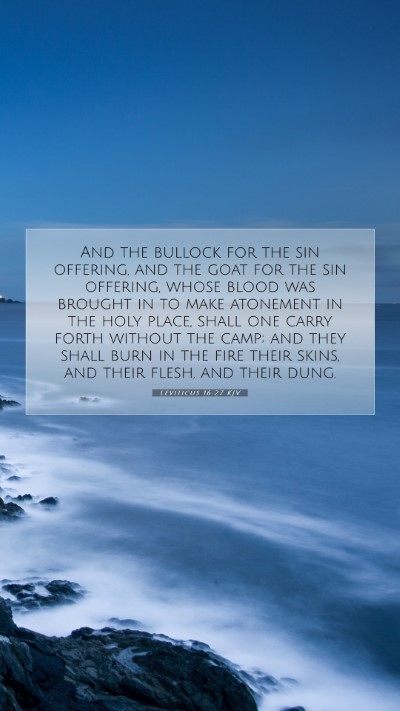Understanding Leviticus 16:27
Bible verse: Leviticus 16:27
Verse Context: This verse is situated within the larger context of the Day of Atonement rituals that are articulated in Leviticus 16. It describes the sacrificial system instituted by God to purify the people of Israel and to provide reconciliation between God and humanity.
Verse Meaning and Interpretation
Leviticus 16:27 states:
"And the bullock for the sin offering, and the goat for the sin offering, whose blood was brought in to make atonement in the holy place, shall be carried forth without the camp; and they shall burn in the fire their skins, and their flesh, and their dung."
This verse symbolizes several key themes:
- Atonement: The sacrificial system exemplifies the serious nature of sin and the way to atone for it.
- Purification: The act of removing the carcasses from the camp reflects the need for purification in the presence of God.
- Symbolism of Sacrifice: The animals' burning signifies the complete offering to God, representing the total commitment required to atone for sin.
Commentary Insights
According to Matthew Henry, this verse emphasizes the need for separation from sin. The animals taken outside the camp illustrate how sin cannot remain in the presence of God's holiness. It underlines the importance of undergoing spiritual cleansing.
Albert Barnes adds that these rituals indicate the gravity of sin. By providing a visual representation of sin's consequences, God teaches the Israelites about the significance of atonement and the lengths required to restore the relationship with Him.
In Adam Clarke's analysis, the notion of burning the carcasses and their remains points toward the eventual destruction of sin. This act served not only as a physical removal of the sin offerings but also as a spiritual lesson on the necessity of casting off sinful practices to draw closer to God.
Symbolism and Theological Significance
The act of carrying the sin offerings outside of the camp holds multi-layered significance:
- Foreshadowing Christ: In Christian theology, the ritual is seen as a foreshadowing of Christ’s ultimate sacrifice for sin. Just as the bull and goat were taken outside the camp, Christ was crucified outside Jerusalem.
- Cleansing and Forgiveness: This ritual coupled with the blood offering symbolizes God’s provision for forgiveness and the path to restoration.
- Holiness of God: The requirement to remove sin outside underscores God's holiness and the unacceptability of sin in His sight.
Application to Daily Life
For modern readers, Leviticus 16:27 offers insightful lessons about the seriousness of sin and the importance of seeking purification in a spiritual sense. Here’s how to apply this understanding:
- Self-examination: Reflect on personal sin patterns and seek constructive ways to turn away from them.
- Spiritual Practices: Engage in prayer and repentance as a means of embracing the purification process.
- Community Reflection: Consider how collective sin within communities can hinder divine presence, prompting a pursuit of holiness.
Cross References
Leviticus 16:27 connects with several other scriptures, providing a broader understanding of its themes:
- Hebrews 13:11-13 - Relating to Christ's sacrifice outside the camp.
- Leviticus 4:12 - Discussing the burning of the sin offering.
- Isaiah 53:6 - Highlighting the concept of atonement through sacrifice.
Biblical Exegesis and Study Resources
For those involved in Bible Study Groups or utilizing online Bible study tools, Leviticus 16:27 serves as a crucial verse for discussion on:
- Understanding the historical context of the Old Testament rites.
- Applying ancient principles to contemporary faith practices.
- Engaging in Biblical exegesis by planning lessons that emphasize atonement and holiness.
Conclusion
Ultimately, Leviticus 16:27 offers profound bible verse explanations relevant for both scholarly reflection and practical application in spiritual life. Understanding Bible verse meanings, biblical contexts, and the weight of sin empowers believers to live more diligently in accordance with God's will.
This verse not only marks a significant point in the sacrificial system but also ties into the larger narrative of redemption and grace that culminates in the New Testament through Jesus Christ. As we study the Scriptures, let us delve into their meanings and allow them to transform our understanding and lives.


